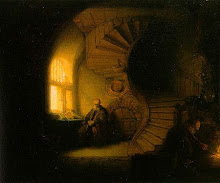I get a letter from a fellow poet younger than me by a few decades, how many I’m not sure, but his exuberance and preference for rap rather than rock indicates at least several. I’m drifting into my late 70s now, unthinkable that’s happening, even though it’s been happening for over 60 years, and I’ve had time to adjust, but haven’t, every day gets a little weirder.
My young friend mentions John Muir in a discussion
about class conflict and the obscenely rich befouling our planet with their
yachts and wars and private jets.
John Muir, yes, a consciousness detached from worldly
pursuits and devoted to the sanctities of the forest, à la Thoreau & Edward
Abbey. People like Abbey, Muir and Thoreau are antidotes to the popularity of the
prosperity gospel in the U.S., which dates back to the 17th century
New England Calvinists, and their twisted notions of material success, and fear
of the forest, except – of course – as potential wealth to extract. Wilderness
terrifies that mindset. They get a kick out of calling experimental writing
“word salad.” Word salad being, in their minds, a put-down. But I love word
salad. Especially with Roquefort and semantic rebellions in my lettuce.
Muir (the name doesn’t come up often) reminds me of my
hippy-dippy days in California in the 60s. Bay Area. Muir was on everyone’s
lips, and most everyone was familiar with the poetry scene, even teenage girls in well-heeled neighborhoods south of San Francisco like Cupertino and Saratoga. Poets had the status of rock stars. A few months ago, while
culling through mountains of memorabilia, I came across a letter from a
girlfriend, 15 at the time (I was 17) raving about Allen Ginsberg. Can you
imagine an average 15 yr old today raving about Allen Ginsberg? What do they
rave about? Taylor Swift?
I never got around to reading John Muir. I order an
ebook from the public library, My First Summer in the Sierra. It’s
marvelous. Full of wild animal joy, to borrow a phrase from Muir. Muir's language is vibrant and alive, "mountan manuscripts," "icy cold, delicious, champagne water" of a mountain creek, or the glassy surface of a still pond mirroring Muir
across the Yosemite of my imagination.
Muir’s prose is vigorous and highly detailed,
constellated with botanical specimens and gorgeous descriptions of the
wilderness that call Albert Bierstadt to mind, open vistas of pristine
grandeur, a turbulence of paint reflecting the violence of creation itself. He
describes Yosemite Creek in a plethora of botanical enthusiasm:
Calm, beautiful, and nearly silent,
it [Yosemite Creek] glides with stately gestures, a dense growth of the slender
two-leaved pine along its banks, and a fringe of willow, purple spirea, sedges,
daisies, lilies, and columbines. Some of the sedges and willow boughs dip into
the current, and just outside of the close ranks of trees there is a sunny
float of washed gravelly sand which seems to have been deposited by some
ancient flood. It is covered with millions of erethrea, eriogonum, and
oxytheca, with with more flowers than leaves, forming an even growth, slightly
dimpled and ruffled here and there by rosettes of Spraguea umbellate.
A single raindrop
explodes into a cosmological garden of Edenic exuberance; he reads the terrain
like a divine manuscript.
How interesting to trace the history
of a single raindrop…Some, falling on meadows and bogs, creep silently out of
sight to the grass roots, hiding softly as in a nest, slipping, oozing, hither,
thither, seeking and finding their appointed work. Some, descending through the
spires of the woods, sift spray through the shining needles, whispering peace
and good cheer to each one of them.
He converts the wilderness
of rock and fern to the wilderness of the word, the towering architecture of
the forest to the spiraling associations among words.
His real purpose for
being in the Sierra that summer (June through September of 1869) was to guide a
flock of sheep through the meadows of the Sierra abounding in rich green grass.
He notes an instance of phantasmagoric revelation: “This evening the show made
by the circle of fire was very fine, bringing out the surrounding trees in most
impressive relief, and making the thousands of sheep eyes glow like a glorious
bed of diamonds.”
Muir – like Thoreau and
Emerson and Whitman – offered a vision of the United States utterly untainted
by the sordid extractions of mining and industry, the worship of technology and
industry and the deathly obsessions with capital and property. To think of the
Sierra as property, as private real estate, is an abomination. Muir’s writing
was instrumental in getting Yosemite to be declared a federally administered
park. Yosemite National Park became a reality in 1890.
What didn’t become a park
is the fullness of being an immersion in the wilderness can induce. You can’t
market the sublime. It’s not for sale. Not up for private ownership. Fewer and
fewer people seem to understand that vital connection. We’re all accustomed to
a culture that elevates the quantifiable over the immeasurable, the incalculable,
the indefinable. Most seem quite well-adapted to it. A suite of luxury
apartments for zombie consumers is worth more than a park or wilderness. How do
you get that juggernaut to turn around after 700 hundred years of plundering
resources? Fortunately, the wilderness is a lot slipperier than people think.
It’s not always where you expect it to be. Sometimes it’s just a moment of
reverie. Although I hear employers may begin implanting chips in the brain to more
rigorously manage those moments stolen from corporate profit. I don’t see that
working. You can’t suppress a wilderness. It’s not always a matter of trees and
ski resorts. It’s a matter of listening. The mountains are a calling. And their
language is in the phosphor of your bones and the ecstasies of your breath.


No comments:
Post a Comment